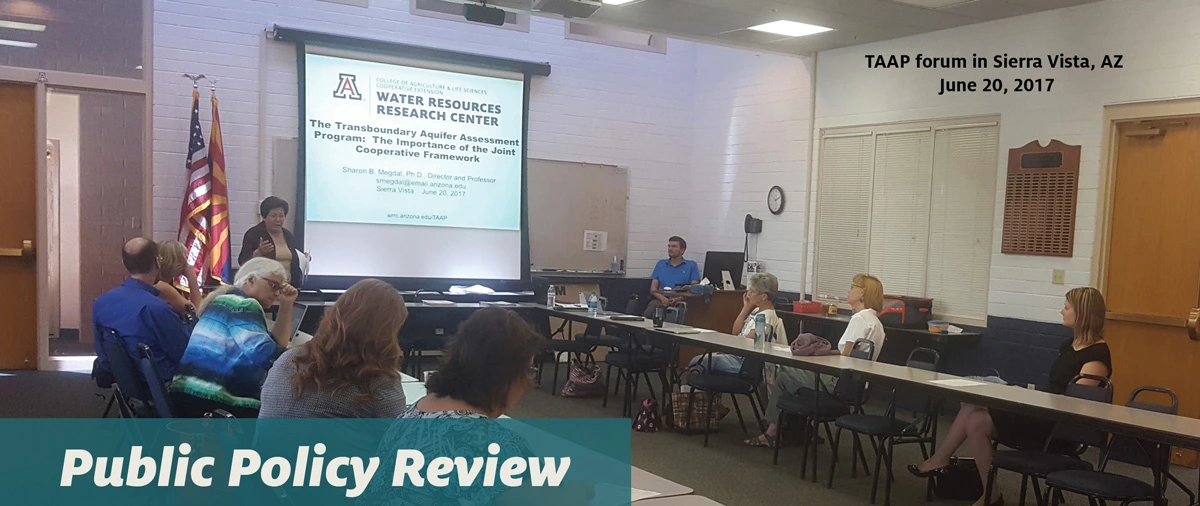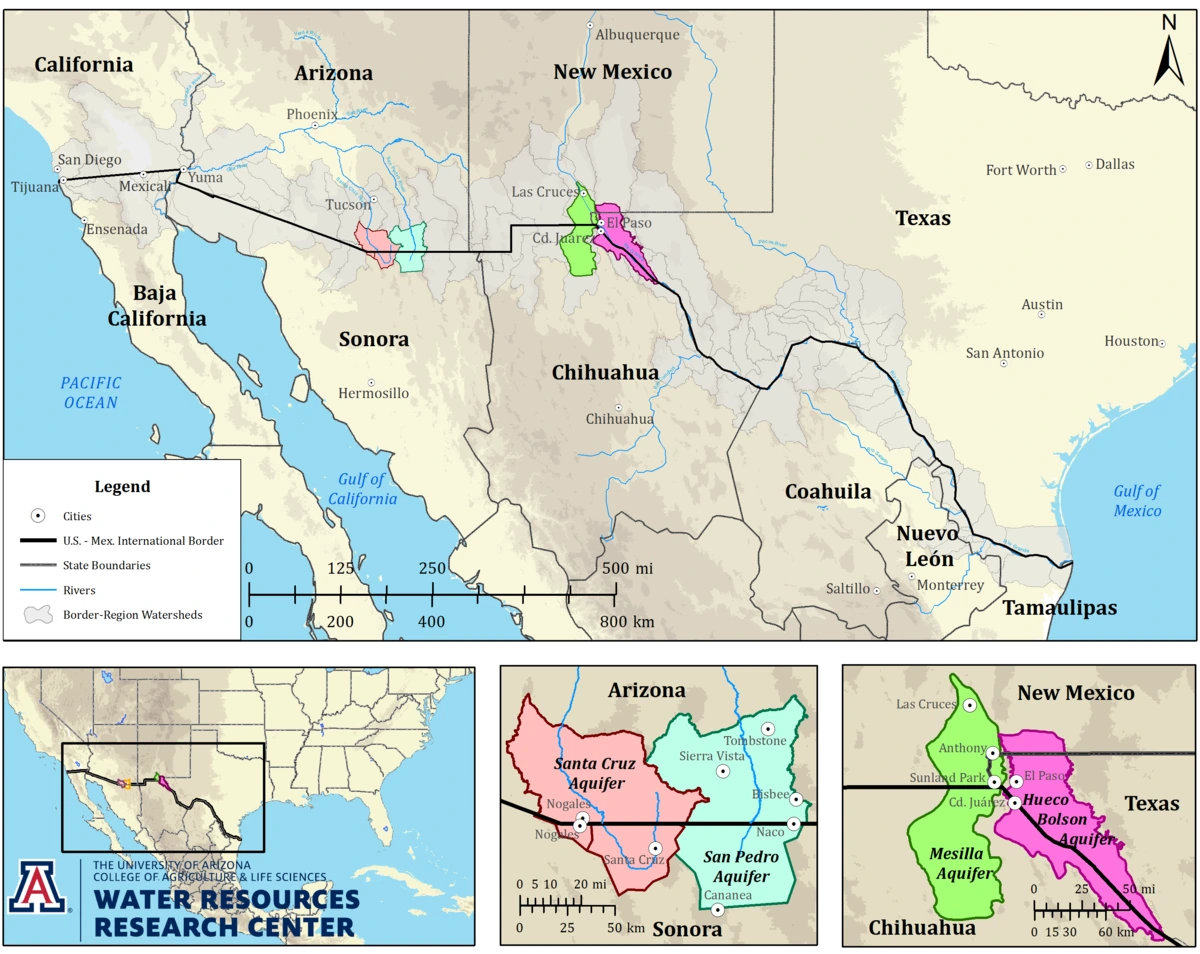A Model for Collaborative Transborder Studies

Being part of the team working on the Transboundary Aquifer Assessment Program (TAAP) continues to be gratifying. The International Boundary and Water Commission’s (IBWC) recent publication of the Binational Study of the Transboundary San Pedro Aquifer (San Pedro Study) marked a milestone. This publication is noteworthy in that it is a first-ever binationally prepared, fully bilingual aquifer assessment, and because it was subject to peer review on both sides of the border. Also noteworthy is the framework for cooperation that has guided the team’s multi-disciplinary and trans-disciplinary collaborative assessment work. Signed on August 19, 2009, IBWC’s “Joint Report of the Principal Engineers Regarding the Joint Cooperative Process United States-Mexico for the Transboundary Aquifer Assessment Program” (Cooperative Framework) took considerable time to develop. The successful ongoing collaboration confirms the value of the time spent at the front-end to develop the Cooperative Framework. The team was able to persevere despite uncertain and very limited funding and the challenges of working in different languages and across an international border. I believe strongly that the Cooperative Framework can serve as a model for both transboundary water studies across the globe, whether or not focused on groundwater.
By way of background, TAAP got its start on the U.S. side with the signing of U.S. Public Law 109-448, the Transboundary Aquifer Assessment Act, in late 2006. I had the honor of serving as the sole non-federal witness at the May 2006 House of Representatives subcommittee hearing on the proposed legislation. The Act articulated U.S. interest in engaging in binational aquifer assessments of specified priority aquifers. While the Act indicated that IBWC would be consulted “as appropriate”, it soon became clear that IBWC involvement would be central to development of the type of assessment authorized by the Act. (For more information on the IBWC, including the Commissioners and staff for the U.S. and Mexican sections, see ibwc.gov and cila.sre.gob.mx/cilanorte.)

Transboundary Aquifer Assessment Program Aquifers of Focus. Source: Water Resources Research Center
The Cooperative Framework establishes that the binational program will be called the Transboundary Aquifer Assessment Program and that the IBWC will serve as the Binational Coordinating Agency. It confirms that the U.S. and Mexican sections are aware of the value of developing an understanding of the aquifers used by both countries. The Cooperative Framework acknowledges the need to develop a team of binational experts to assess aquifers, exchange data, and if necessary, develop new datasets. The document states that the “IBWC, under this joint cooperative process, will provide the framework for coordination of binational assessment activities conducted by U.S. and Mexican agencies, universities, and others participating in the program,” … “to improve the knowledge base of transboundary aquifers between the United States and Mexico”. Additional key provisions include assuring that both countries concur on transboundary aquifer assessment activities and specifying binational technical advisory committees for each identified transboundary aquifer. The IBWC was named as the official repository for binational project reports to be published in Spanish and English. Importantly, IBWC is responsible for developing a joint program and for determining whether a proposed aquifer study is in the interest of both countries. The IBWC also coordinates with agencies for both countries in defining the scope of the assessment and facilitating agreement on work plans. However, the Cooperative Framework specifies that “each country will be responsible for any costs on projects conducted in its territory, in addition to selecting the participants and consultants to carry out the studies in that country. Each country may contribute to costs for work done in the other country, and the IBWC will coordinate any flow of funds across the border.” The six principles of agreement, which appear toward the end of the three-page document, make it clear that each country is free to undertake its own studies when such are limited to one side of the border.
The six Principles of Agreement are as follows.
- Activities described under this agreement should be beneficial to both countries.
- Aquifers to be jointly studied, as well as the scope of the studies or activities to be done on each aquifer, should be agreed upon within the framework of the IBWC.
- The activities should respect the legal framework and jurisdictional requirements of each country.
- No provisions set forth in this agreement will limit what either country can do independently in its own territory.
- Nothing in this agreement may contravene what has been stipulated in the Boundary and Water Treaties between the two countries.
- The information generated from these projects is solely for the purpose of expanding knowledge of the aquifers and should not be used by one country to require that the other country modify its water management and use.
There is much global interest in governance and management of transboundary groundwater. The international legal community and others have for some time been advocating for UN adoption of the 2008 Draft Articles on the Law of Transboundary Aquifers (Draft Articles). I pointed out that the Cooperative Framework is consistent with two important provisions of the Draft Articles in my first international presentation on TAAP at Stockholm’s World Water Week on August 20, 2009, (the day after the signing of the Cooperative Framework) and again as recently as the 2017 World Water Congress in late May. Both “Article 7, §2: General Obligation to Cooperate” and “Article 8, §2: Regular exchange of data and information” speak to the desirability of cooperative study.
A common understanding of aquifer conditions is a first step in efforts to explore binational governance and management. Disagreement about groundwater conditions is likely to lead to different perspectives on approaches to groundwater management. Because it is beyond the scope of TAAP responsibility, the expert team has been silent on the prospects for binational groundwater management along the U.S.-Mexico border. Instead, the TAAP team has focused on expanding shared knowledge and understanding. Since 2009, the Cooperative Framework has facilitated successful completion of the San Pedro Study, with completion of a similar study for the transboundary Santa Cruz aquifer in progress. In addition, binational efforts are continuing for the other TAAP aquifers, as shown on the map of TAAP transboundary aquifers. The basic elements of the Cooperative Framework can serve as a model for others engaged in transborder studies. The Cooperative Framework, a link to the San Pedro Report, and other information on TAAP history and activities, particularly for the Arizona-Sonora transboundary aquifers, can be found within our site.

